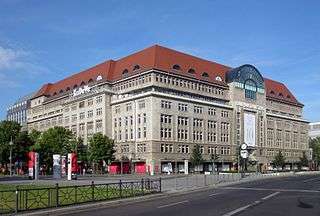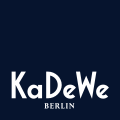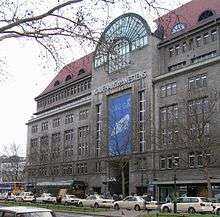Kaufhaus des Westens
The Kaufhaus des Westens (German for '"Department Store of the West"'), usually abbreviated to KaDeWe, is a department store in Berlin. With over 60,000 square metres of selling space and more than 380,000 articles available, it is the second largest department store in Europe after Harrods in London. It attracts 40,000 to 50,000 visitors every day.

The store is located on Tauentzienstraße, a major shopping street, between Wittenbergplatz and Breitscheidplatz, near the centre of the former West Berlin. It is technically in the extreme northwest of the neighbourhood of Schöneberg.
Since 2015, KaDeWe has been owned by the Central Group, a Thailand-based international department store conglomerate.[1]
History
Former neon sign |
 Present logo | ||

The store was founded in 1907 by Abraham Adolf Jandorf, who persuaded the architect Emil Schaudt to build his store. It opened on 27 March 1907 with an area of 24,000 sq m.[2]
In June 1927, ownership changed to the Hermann Tietz, who was responsible for modernizing and expanding the store. They had the ambition to add two new floors but because of the Nazi rise to power in the 1930s their plans came to a sudden halt. Hermann Tietz was a Jewish owned partnership and because of the Nazis' race laws the company was aryanized by duress and its name changed to Hertie. During World War II, Allied bombing ruined most of the store, with one shot-down American bomber actually crashing into it in 1943. Most of the store was gutted, which caused its closure. The re-opening of the first two floors was celebrated in 1950. Full reconstruction of all seven floors was finished by 1956. "KaDeWe" soon became a symbol of the regained economic power of West Germany during the Wirtschaftswunder economic boom, as well as emblematic of the material prosperity of West Berlin versus that of the East.[2]
Between 1976 and 1978, the store's floor space was expanded from 24,000 sq m to 44,000 sq m. Just after the fall of the Berlin Wall in 1989, KaDeWe recorded a record-breaking number of people going through the store. By 1996, with a further floor and restaurant added, the sales area had expanded to 60,000 sq m.[2]
In 1994, the KarstadtQuelle AG corporation acquired Hertie and with it KaDeWe. Most of the floors were renovated between 2004 and 2007 in preparation for the store's one hundredth anniversary.
In January 2014, a majority stake in Karstadt Premium GmbH was acquired by the Signa Holding GmbH.[3] In 2015, it was acquired by the Central Group.
Features

KaDeWe has eight floors, each focused on a different type of merchandise.
The ground floor is all beauty accessories and luxury goods. The services offered include beauty salons as well as nail and foot spas.
The so-called "Luxury Boulevard" is also situated here, with various luxury brands.
The 1st floor is men's apparel.
The 2nd floor is devoted to women's fashion.
The 3rd floor is referred to as "the Loft" and is Germany's biggest luxury shoe department. Women's leather goods and lingerie are sold here, too.
The 4th floor contains interior and design items, as well as the in-house wedding and gift registry services.
The 5th floor is arts, books, entertainment, electronics, toys, office supplies, and souvenirs.
The 6th and 7th floors are entirely devoted to food, and advertisements tout the place as having two football fields of food. The 6th floor food hall is called "Delicatessen" and is famous for its wide variety of food and beverages. It has around 110 cooks and 40 bakers and confectioners supplying more than 30 gourmet counters. The top floor (added in the early 1990s) includes a winter garden with a 1000-seat restaurant surrounded by an all-windowed wall offering a view over the Wittenbergplatz.
Bibliography
- Antonia Meiners: 100 Jahre KaDeWe. Nicolaische Verlagsbuchhandlung, Berlin 2007, 168 p., 80 colour photos, 80 b&w photos, clothbound, ISBN 978-3-89479-386-9, summary in german
- Nils Busch-Petersen: Adolf Jandorf – Vom Volkswarenhaus zum KaDeWe, Hentrich & Hentrich, Berlin 2007, 80 p., ISBN 978-3-938485-10-1
References
- "Central Department Store Group (CDG)". Central Group. Retrieved 24 January 2017.
- KaDeWe Archived 2012-03-05 at the Wayback Machine, City of Berlin
- Archived 2017-06-24 at the Wayback Machine, KaDeWe Berlin company Web site
External links
| Wikimedia Commons has media related to Kaufhaus des Westens. |
- KaDeWe - Kaufhaus des Westens in Berlin, (English)
- Europe's Biggest Department Store featuring history of KaDeWe, berlin-life.com
- „Seventh Heaven“, Christophorus, No. 326, The Porsche Magazine, June/July 2007, p. 66 - 74.
- „Not heaven, but not hell either“, signandsight.com, December 22, 2005 by Roger Boyes
- Fare Of The Country; In One Berlin Store, Food Without End, New York Times, March 10, 1991
